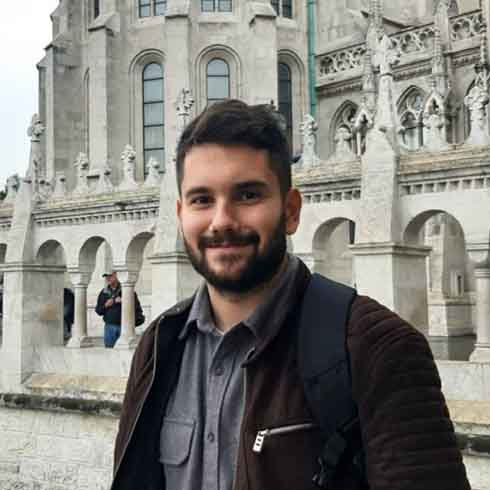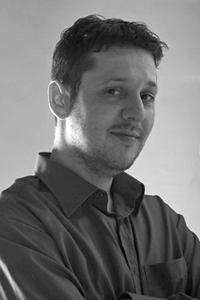Course is active from 17.07.2017..
Enabling students to create interactive visualizations and user intuitive interfaces for various types of augmented (AR) and virtual (VR) realities.
To apply the acquired knowledge to specific tasks and problems in future professional work.
Introduction and definition of basic concepts of interactive visualization systems. Theory and application of interactive visualization virtual reality (VR), augmented reality (AR) and mixed reality. Application of VR technology to organize, define and function the scene for interaction within 3D space. Technological procedure of applying extended reality with marker method and positioning method using GPS systems and gyroscopes. Simultaneous localization and mapping (SLAM) methods in augmented reality applications. Creating a user interface for navigating and managing an interactive 3D model. Preparation of special effects in VR and AR. Work on creation of 3D ambiances with real-time software tools. Tools for creating interactive visualizations: Unity 3D, Unreal Engine, TurnTool, Adobe Premier.
Lectures in classroom and exercises in a computer laboratory. Consultations. During the semester students work on 2 tasks: creating scenes for VR and AR with user interface and special effects. Tasks are evaluated and grades are pre-examined. Students go to the oral part of the exam and defend the work, using HMD set and mobile applications. Assessment of the exam is based on the attendance of lectures and exercises, task making and oral defense of work.
| Authors | Name | Year | Publisher | Language |
|---|
| Aukstakalnis, S. | Practical Augmented Reality: A Guide to the Technologies, Applications, and Human Factors for AR and VR | 2017 | Addison-Wesley Professional | English |
| S. LaValle | Virtual reality | 2017 | Cambridge University Press | English |
| J. Linowes | UNITY VIRTUAL REALITY PROJECTS | 2015 | Packet Publishing | English |
| T. Shannon | Unreal engine 4 for design visualisation: developing stunning interactive visualisations, animations and renderings | 2017 | Addison-Wesley | English |
| Francis Glebas | Directing the Story: Professional Storytelling and Storyboarding Techniques for Live Action and Animation 1st Edition | 2008 | Focal Press | English |
| David Harland Rousseau | Storyboarding Essentials: SCAD Creative Essentials (How to Translate Your Story to the Screen for Film, TV, and Other Media) | 2013 | Watson-Guptill | English |
| Ron Brinkmann | The Art and Science of Digital Compositing: Techniques for Visual Effects, Animation and Motion Graphics (The Morgan Kaufmann Series in Computer Graphics) 2nd Edition | 2008 | Morgan Kaufmann | English |
| Peter Rubin | Future Presence: How Virtual Reality Is Changing Human Connection, Intimacy, and the Limits of Ordinary Life | 2018 | HarperOne | English |
| Dele Atanda | The Digitterian Tsunami: Web 3.0 and the Rise of the NEO Citizen (The 21 Pricnciples Driving The Evolution of The Internet) (Volume 1) | 2013 | CreateSpace Independent Publishing Platform | English |
| Eric Lengyel | Foundations of Game Engine Development, Volume 1: Mathematics | 2016 | Terathon Software LLC | English |
| Jason Gregory | Game Engine Architecture, Third Edition | 2018 | A K Peters/CRC Press | English |
| Jesse Schell | The Art of Game Design: A Book of Lenses | 2014 | A K Peters/CRC Press | English |
| Christine Lion-Bailey | Reality Bytes: Innovative Learning Using Augmented and Virtual Reality | 2020 | Dave Burgess Consulting | English |
| Erin Pangilinan , Steve Lukas, et al. | Creating Augmented and Virtual Realities: Theory and Practice for Next-Generation Spatial Computing | 2019 | O'Reilly Media | English |
| John L. Steadman | Aliens, Robots & Virtual Reality Idols in the Science Fiction of H. P. Lovecraft, Isaac Asimov and William Gibson | 2020 | Zero Books | English |
| John Bucher | Storytelling for Virtual Reality: Methods and Principles for Crafting Immersive Narratives | 2017 | Routledge | English |
| Jonathan Linowes and Krystian Babilinski | Augmented Reality for Developers: Build practical augmented reality applications with Unity, ARCore, ARKit, and Vuforia | 2017 | Jonathan Linowes and Krystian Babilinski | English |
| Course activity | Pre-examination | Obligations | Number of points |
|---|
| Complex exercises | Yes | Yes | 70.00 |
| Theoretical part of the exam | No | Yes | 30.00 |
| Name and surname | Form of classes |
|---|
 | | Lectures |
 | | Lectures |
 | | Lectures |
 | | Computational classes |
 | | Computational classes |
 | | Computational classes |
 | | Computational classes |





